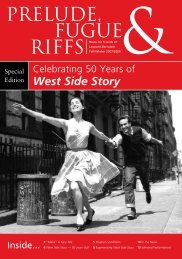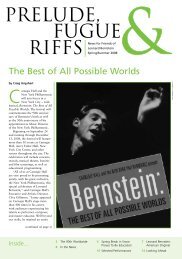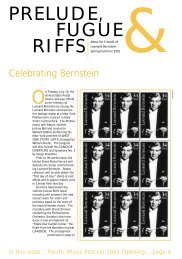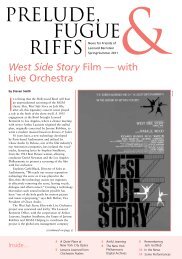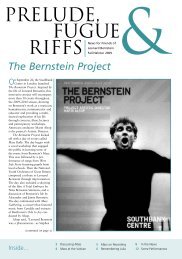Prelude, Fugue & Riffs - Leonard Bernstein
Prelude, Fugue & Riffs - Leonard Bernstein
Prelude, Fugue & Riffs - Leonard Bernstein
You also want an ePaper? Increase the reach of your titles
YUMPU automatically turns print PDFs into web optimized ePapers that Google loves.
<strong>Prelude</strong>, <strong>Fugue</strong> & <strong>Riffs</strong> Spring/Summer 2004<br />
4<br />
Sandra Ervin,<br />
Dr. Thomas<br />
Dohrmann,<br />
Alexander<br />
<strong>Bernstein</strong>,<br />
Betty Gray,<br />
Anna Johnson,<br />
Johnny Johnson,<br />
Dr. Richard<br />
Benjamin,<br />
Susan Hanson,<br />
Patrick Bolek<br />
Artful Learning:<br />
The ”Hook” for Student Achievement<br />
by Susan Hanson<br />
As visiting teachers walk down<br />
the hallways of Harmony<br />
Leland Elementary School in Cobb<br />
County, Georgia, they often hear<br />
this comment from students: “Do<br />
the teachers in your school teach<br />
like this? If not, they should.”<br />
Visitors always see a love for<br />
learning on the faces of these students<br />
and teachers. What causes<br />
the excitement in this school?<br />
It is the <strong>Leonard</strong> <strong>Bernstein</strong><br />
Artful Learning Model — the<br />
arts-based school improvement<br />
program that prepares teachers to<br />
engage students through the use<br />
of arts and artistic processes. This<br />
model is designed to strengthen<br />
teaching and learning by integrating<br />
the arts into standard teaching<br />
practice. However, <strong>Bernstein</strong><br />
teachers usually teach beyond the<br />
standards. Artful Learning<br />
instruction engages students in a<br />
masterwork; creates inquiry<br />
through a significant question;<br />
and allows students to demonstrate<br />
learning through original<br />
creations. Finally, they reflect on<br />
what was learned by responding<br />
to ever deepening questions.<br />
Six years ago, Principal Sandra<br />
McGary Ervin, along with the<br />
former Cobb District Superintendent,<br />
Dr. Richard Benjamin,<br />
implemented the <strong>Bernstein</strong> Artful<br />
Learning Model as a school-wide<br />
initiative to create a focus and<br />
improve learning. This Title 1<br />
School once had low test scores<br />
and high student absentee and<br />
transience rates. Today, test scores<br />
are improving, students and<br />
teachers are engaged in learning,<br />
and visitation days have to be<br />
scheduled to accommodate the<br />
large demand of national and<br />
international visitors wanting to<br />
tour the school.<br />
Using the <strong>Bernstein</strong> Artful<br />
Learning Model, Harmony Leland<br />
students learn research-based<br />
strategies to improve achievement<br />
and demonstrate to all a love for<br />
learning. For this model to be<br />
successful, the school focuses on<br />
many transformational steps.<br />
Teachers meet regularly to coordinate<br />
their curriculum, instruction<br />
and assessment, which helps them<br />
create their <strong>Bernstein</strong> units of study.<br />
Weekly, teachers receive professional,<br />
high quality, on-site staff<br />
development establishing a shared<br />
vision where teachers become<br />
learners along with the students.<br />
An important component in<br />
the success of this program is that<br />
the parents of the students are also<br />
trained in the <strong>Bernstein</strong> Model.<br />
The parent facilitator at the school<br />
offers bi-monthly meetings to<br />
instruct parents on the strategies<br />
COURTESY LEONARD BERNSTEIN CENTER<br />
students are learning in their<br />
classrooms. If parents participate<br />
in at least six sessions throughout<br />
the school year, they graduate from<br />
Parent University at the award<br />
ceremony that ends the school<br />
year. These training sessions have<br />
proven to be an extremely effective<br />
way to get parents to facilitate<br />
student achievement.<br />
The Principal, Ms. Ervin,<br />
meets with the parents at each<br />
grade level once a year reviewing<br />
their child’s performance and sets<br />
goals for achievement. In the<br />
spring of each year, there is a<br />
“State of the State” address for<br />
parents, students and teachers<br />
about the school’s performance.<br />
Reflection is an important<br />
strand of the Artful Learning<br />
Model. Harmony Leland implements<br />
a school-wide strategy for<br />
writing, meaning that teachers<br />
are responsible not only for students’<br />
writing scores, but also for<br />
setting benchmarks to improve<br />
writing scores for the entire<br />
school. The staff believes writing<br />
is the number one indicator of<br />
student assessment.<br />
Relationships, collaboration<br />
and teacher leadership are key<br />
concepts to the success of the<br />
<strong>Bernstein</strong> Model. Teachers at<br />
Harmony Leland work collegially<br />
in “critical friends” groups to<br />
analyze student work. They<br />
bring student writing to the table<br />
to decide what exemplary writing<br />
should look like for all students.<br />
This way of working as colleagues<br />
helps teachers improve their<br />
instruction by giving and receiving<br />
authentic feedback from one<br />
another. The goal at Harmony<br />
Leland is “striving for excellence,<br />
sparking creativity, working<br />
together hand in hand.” Art is<br />
the glue that holds this school’s<br />
vision together. ■<br />
Susan Hanson is a national trainer<br />
for the <strong>Leonard</strong> <strong>Bernstein</strong> Artful<br />
Learning Model and a <strong>Bernstein</strong><br />
Facilitator at Harmony Leland<br />
Elementary School.<br />
Arts-based Lessons a Hit<br />
in West Des Moines, Iowa<br />
by Megan Hawkins<br />
Register Staff Writer<br />
March 27, 2004<br />
Kindergartner Kobi Ozimek<br />
glanced at the painting on the<br />
wall, rolled his eyes upward, and<br />
then thoughtfully named its<br />
famous creator: “Norman . . .<br />
Rockwell.”<br />
The boy is not in a special<br />
class for art prodigies. He and<br />
his West Des Moines classmates<br />
are participating in a learning<br />
method used by only 35 school<br />
districts in the nation. They<br />
study the arts to link lessons from<br />
different subject areas together in<br />
a program called the Grammy<br />
Foundation <strong>Leonard</strong> <strong>Bernstein</strong><br />
Center for Learning model.<br />
Students at Phenix, Rex Mathes<br />
and Clegg Park elementary school<br />
are completing their first units,<br />
which teachers planned and prepared<br />
for months.<br />
“They’re being exposed to<br />
things they wouldn’t learn otherwise,”<br />
said Judy Snyder, a Rex<br />
Mathes Elementary kindergarten<br />
teacher. “I think they really<br />
understand and can articulate the<br />
ideas so much better.”<br />
The district adopted the program<br />
to boost test scores, in<br />
hopes that creative activities would<br />
appeal to students and help them<br />
learn. The model has proven<br />
especially effective for “at-risk”<br />
students at other schools, typically<br />
minority students or those from<br />
low-income households. The<br />
three West Des Moines schools<br />
using the model have a large<br />
number of “at-risk” students.<br />
Schools across Iowa and the<br />
nation are struggling to find<br />
effective ways to narrow the<br />
achievement gap between poor<br />
and minority students and their<br />
more affluent peers.<br />
While many of the lessons<br />
have not changed, the ideas are<br />
taught differently, educators said.<br />
Instead of talking about communication,<br />
for example, kindergartners<br />
watched Swan Lake and<br />
made foil sculptures of dancers<br />
to show how they communicate<br />
through body language.<br />
Using the arts “expands the<br />
lesson. We’re taking it to a higher<br />
level of thinking,” said Phyllis<br />
Staplin, curriculum director.<br />
The arts-based model challenges<br />
students to think more independently<br />
and make more connections<br />
between lessons in different subject<br />
areas, Staplin said.<br />
In the units, students:<br />
• Study a piece of art, such as a<br />
painting or song. They answer a<br />
general question that relates to<br />
the art and other lessons, typically<br />
something broad like, “How do<br />
we communicate with the world<br />
around us?”<br />
COURTESY LEONARD BERNSTEIN CENTER<br />
• Do hands-on, independent<br />
activities at inquiry centers, or<br />
stations that teachers set up, with<br />
activities ranging from drawing a<br />
partner’s body language to identifying<br />
instruments in a song.<br />
Older students work on murals<br />
and timelines.<br />
• Share their own original<br />
creation, such as a collage or<br />
a performance.<br />
The concept also is worked<br />
into class lessons.<br />
Third-graders, who studied<br />
synthesis and the idea of parts<br />
making a whole, studied separate<br />
regions that make up Australia,<br />
the various parts that make up a<br />
story, and combined ingredients<br />
to make a sandwich, for example.<br />
“It’s really fun,” said an enthusiastic<br />
Lyndsie Angus, 8, a thirdgrader<br />
at Clegg Park.<br />
Her mother, Kelly Angus, who<br />
also has a fifth-grade daughter<br />
at Clegg Park, is supportive of<br />
the program.<br />
“It gives students different<br />
angles, different ways to learn,”<br />
she said. “Not everyone learns<br />
the same way, so this gives them<br />
a chance to apply (their talents).”<br />
Teachers said they like the<br />
program, although they noted<br />
that it takes many extra hours of<br />
work and collaboration to plan<br />
the units, which must mesh into<br />
their usual curriculum. They<br />
now have one unit that they<br />
will tweak and use again next<br />
year. Educators said they hope to<br />
have another new unit ready for<br />
next year so they can do one<br />
each semester.<br />
Students’ work will be evaluated,<br />
and both attendance and<br />
test scores will be monitored for<br />
the next few years to determine<br />
the program’s effectiveness at<br />
each school. ■<br />
Reprinted by permission from the<br />
Des Moines Register.<br />
Dr. Donna Wilkin,<br />
Dr. Phyllis Staplin,<br />
Alexander<br />
<strong>Bernstein</strong>,<br />
Dr. Robert Davis,<br />
Susan Moritz,<br />
John Villotti,<br />
Dr. Les Omotani,<br />
Patrick Bolek<br />
<strong>Prelude</strong>, <strong>Fugue</strong> & <strong>Riffs</strong> Spring/Summer 2004 5




